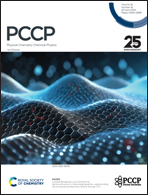Enhanced intramolecular charge transfer and near-infrared fluorescence in 4-dimethylamino-chalcone analogues through extended conjugation: synthesis, photophysical properties, and theoretical modelling†
Abstract
The distinctive characteristics of near-infrared fluorescent organic molecules render them indispensable across diverse applications, from energy harvesting to bioimaging and sensing technologies. In this work, we continue our investigation on the chalcone derivative, 4-dimethylamino-2′-hydroxychalcone (nDHC, n = 1; where n is the number of olefinic bonds), by expanding the number of central double bonds (n = 2 (2DHC) and n = 3 (3DHC)). Additionally, we also synthesized the structurally related chalcones lacking the OH group (DC, 2DC, 3DC) in order to obtain a comprehensive understanding of their effects on the intramolecular charge transfer (ICT). The results show remarkable bathochromic shifts in absorption and fluorescence peaks in solution as n increases. These shifts, 20 nm and 35 nm for absorption and 100 nm and 200 nm for fluorescence in 2DHC and 3DHC, respectively, signify enhanced ICT and a significant increase in the excited state's dipole moment. The presence of OH groups notably amplifies these shifts due to additional electron donation, influencing solute–solvent interactions in solution. Femtosecond fluorescence upconversion and transient absoprtion techniques unraveled distinct dynamics in these derivatives, exhibiting the dominance of vibrational cooling, solvation, and intramolecular motions, particularly in the larger conjugated systems 3DHC and 3DC. The observed changes in the femtosecond transinet absorption spectra suggest the existence of new active states in extended conjugation systems, indicating diverse intramolecular conformational states contributing to their relaxation dynamics. The results of this study provide invaluable insights into excited-state spectroscopy, offering a roadmap for tailoring chalcone derivatives for specific applications.



 Please wait while we load your content...
Please wait while we load your content...